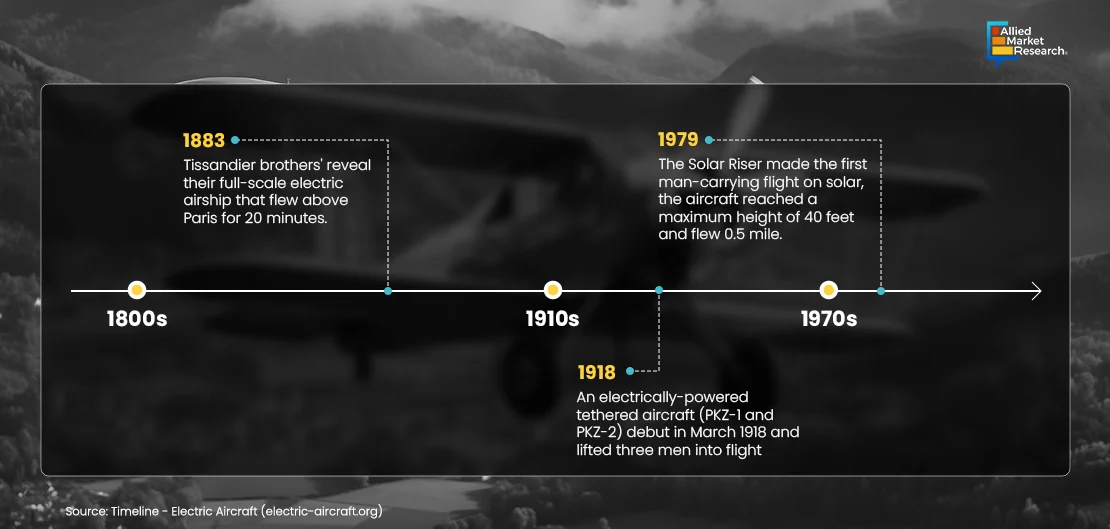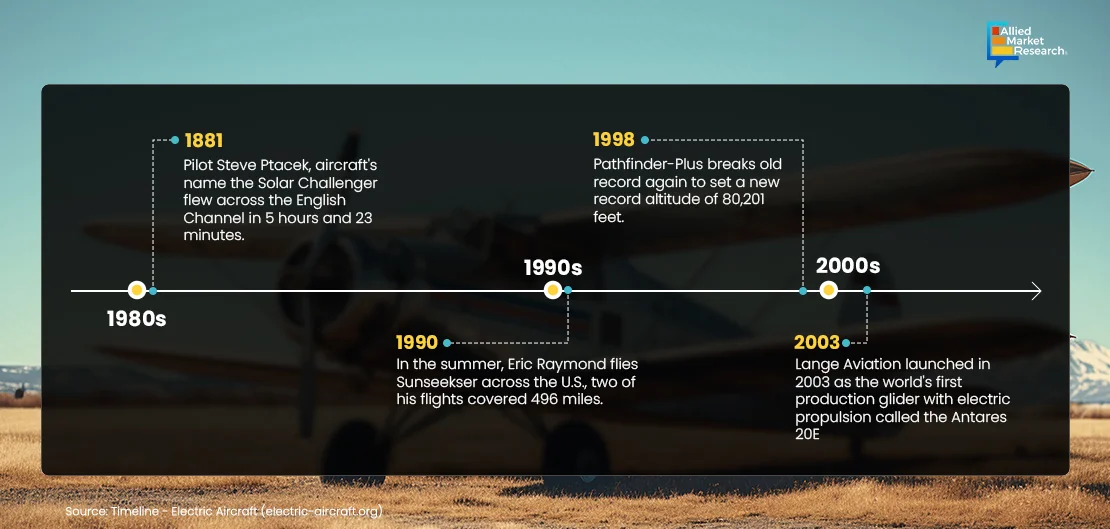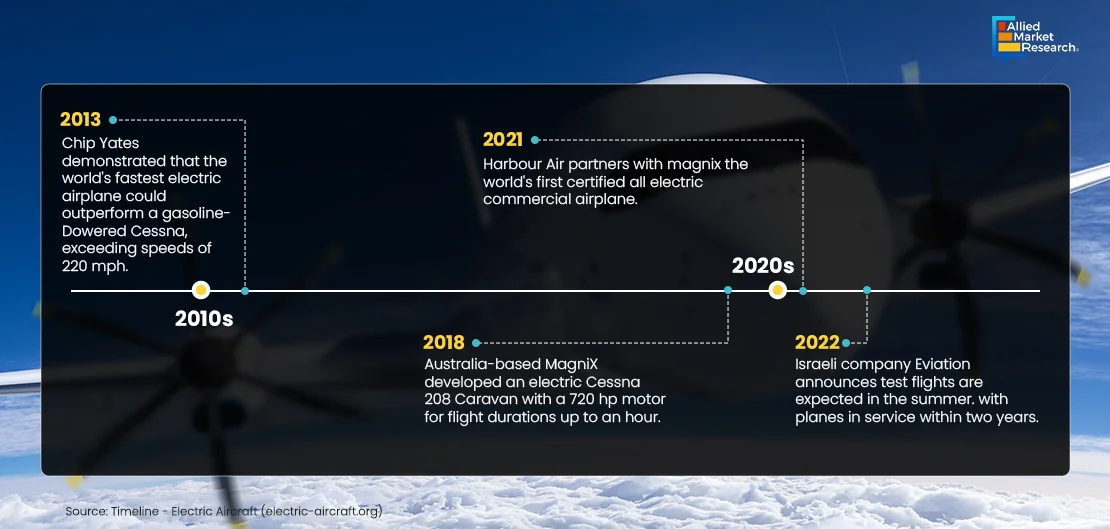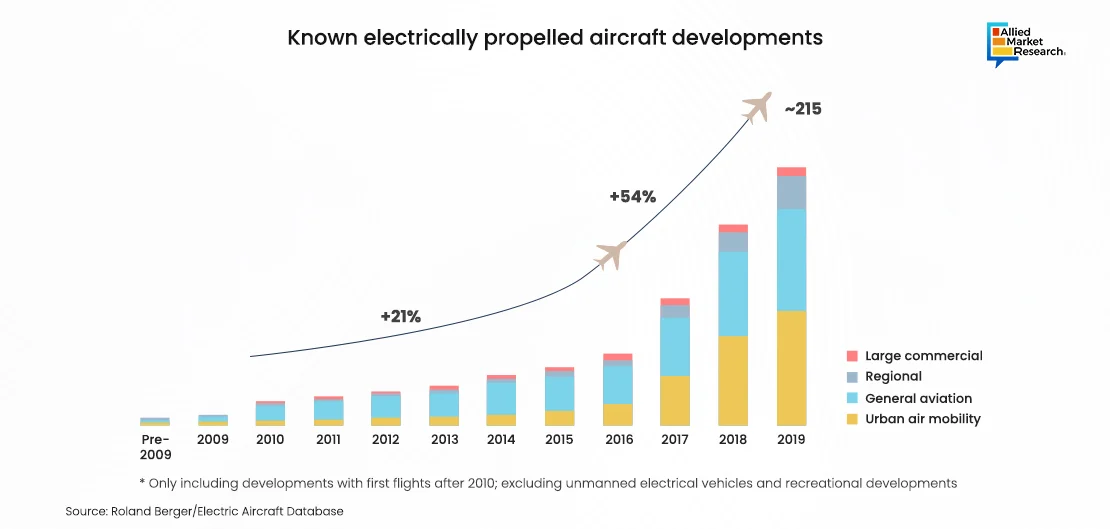Table Of Contents

Lalit Janardhan Katare

Koyel Ghosh
Electric Aircraft: A Vision for Sustainable Aviation

In recent years, the aviation industry has undergone a significant change due to the need to address environmental concerns and be more eco-friendly. This change is mainly driven by the urgent requirement to reduce carbon emissions. At the heart of this industry-wide shift is the electric aircraft market, a dynamic and innovative sector that has the potential to reshape the direction of aviation toward sustainability.
Electric planes are revolutionizing aviation compared to traditional planes with combustion engines. Unlike their traditional counterparts, electric aircraft rely on electric propulsion systems driven by batteries and electric motors. This fundamental difference brings about several notable distinctions. These aircraft are inherently more environmentally friendly, producing fewer carbon emissions and contributing to a greener aviation industry. Moreover, they operate with reduced noise levels, addressing concerns about noise pollution in aviation. While traditional aircraft are constrained by the availability of fossil fuels, electric aircraft benefit from the increasing efficiency and accessibility of electric power sources.

The Evolution of Electric Aviation
The roots of electric aviation can be traced back to the 19th century, with early experiments in electric airship flights. However, it is in recent decades that significant strides have been made, spurred by advancements in battery technology, lightweight materials, and a growing global awareness of the environmental impact of traditional aviation. Here is the timeline for the evolution of electric aircraft:
1883: The Tissandier brothers amazed everyone when they showed off their big electric airship, flying it over Paris for 20 minutes.
1918: In March, the PKZ-1 and PKZ-2 electric tethered aircraft took off, lifting three people into the air. This was a big deal for early electric flight experiments.

1979: The Solar Riser made history by being the first solar-powered plane to carry a person. It flew up to 40 feet high and covered half a mile.
1981: A pilot named Steve Ptacek flew the Solar Challenger across the English Channel in just over 5 hours. It was a solar-powered plane making a long journey.
1990: During the summer, Eric Raymond flew the Sunseeker across the U.S., covering an impressive 496 miles in two flights. This showed that electric planes could go the distance.
1998: The Pathfinder-Plus broke records by reaching an incredible altitude of 80,201 feet, which is extremely high in the sky!

2003: Lange Aviation unveiled the Antares 20E, marking a significant advancement in the popularity of electric planes.
2013: Chip Yates proved that the world's fastest electric airplane could beat a regular Cessna, going faster than 220 mph.
2018: An Australian company called MagniX made an electric Cessna 208 Caravan with a strong 720 hp motor. This plane could fly for about an hour.

2021: Harbour Air and magniX joined forces to make the first ever certified all-electric commercial airplane. That's a big step for electric planes in regular air travel.
2022: An Israeli company, Eviation, announced they're planning test flights in the summer. They hope to have their electric planes in service within two years. So, the journey of electric planes continues to the future!
Technological Advancements
The electric aircraft market is growing quickly because battery technology is advancing rapidly. Lithium-ion batteries, specifically, have undergone a noteworthy transformation, becoming not only lighter but also more efficient, empowering them to deliver the requisite power for extended flight durations. The impressive progress has motivated companies like MagniX and Eviation to excel with innovative electric aircraft projects. These companies are actively engaged in the development of robust electric motors and advanced battery systems, thereby transforming the vision of long-range electric flights into a tangible reality.
Instances of this technological surge include MagniX's collaboration with AeroTEC to retrofit a Cessna 208 Caravan with an electric propulsion system. The successful test flights of the modified electric aircraft highlight the efficacy of advancements in battery technology for practical aviation applications. Eviation's decision to test-fly their all-electric aircraft, Alice, shows their belief in advancing battery technology, which helps make electric aviation sustainable and economically feasible. These examples show how improvements in battery technology are driving the electric aircraft industry forward.
Market Players and Innovations
The electric aircraft industry is driven by key players who actively innovate and shape the industry. Prominent companies such as Pipistrel, Airbus, and Boeing are making substantial investments in research and development to pioneer electric and hybrid-electric propulsion systems. Their commitment to advancing technology is evident in the transformative impact it has on the aviation sector.
Pipistrel, a recognized leader, has been at the forefront of developing electric aircraft, including the Velis Electro, the world's first type-certified electric airplane. This pioneering achievement highlights Pipistrel's dedication to pushing the boundaries of electric aviation.
Airbus, a major player in the aerospace industry, has been actively engaged in projects like the E-Fan X program, aiming to explore hybrid-electric propulsion for regional aircraft. Their innovative approaches contribute significantly to the evolution of sustainable aviation solutions.
Boeing, another industry giant, is leveraging its expertise to delve into electric aviation. Boeing and MagniX are working together to equip a Cessna 208 Caravan with an electric propulsion system, showing their dedication to embracing and using electric technologies. Complementing these established entities, startups such as Joby Aviation and Vertical Aerospace are making noteworthy contributions. Joby Aviation is focused on developing electric vertical takeoff and landing (eVTOL) aircraft, envisioning a future where urban air mobility is revolutionized by clean energy solutions. Vertical Aerospace, on the other hand, is pioneering eVTOL technology with a commitment to creating efficient and sustainable aerial transportation options.
These diverse examples showcase the industry's vibrant ecosystem, with both established players and innovative startups actively shaping the electric aircraft industry. These groups are working together toward a sustainable and transformative future in aviation.
Environmental Impact and Sustainability
The shift toward electric aviation is not merely a technological trend; this step is essential for reaching sustainability goals in aviation. Electric aircraft produce significantly fewer carbon emissions than traditional combustion engines, contributing to a reduction in the overall carbon footprint of air travel. As governments and airlines globally aim for zero emissions, the electric aircraft market offers promise in meeting these environmental targets
Case Study
Case Study 1: E-Commute Solutions with Lilium's Air Taxis
Background:Lilium, a German aviation startup, aims to revolutionize urban transportation with its electric vertical takeoff and landing (eVTOL) aircraft. The company envisions an efficient and sustainable mode of daily commuting through air taxis.
Solution: Lilium's electric aircraft, known as the Lilium Jet, is designed for short, emissions-free trips within urban areas. The five-seater aircraft utilizes a distributed propulsion system with electric jet engines, allowing it to take off and land vertically. The company is conducting trials and simulations for urban air mobility, showcasing the potential for reducing traffic congestion and providing a rapid and eco-friendly commuting solution.
Results: Lilium's innovative approach to urban air mobility presents a case where electric aircraft can transform daily commuting, offering a scalable and sustainable solution to address urban transportation challenges.
Case Study 2: Sustainable Luxury Travel with Alice by Eviation
Background: Eviation Aircraft, an Israeli company, developed Alice, an all-electric aircraft designed for regional travel. The aircraft emphasizes sustainability and luxury, catering to a market seeking eco-friendly options for private and corporate air travel.
Solution:Alice features an innovative design with a large cabin and nine passengers' seating capacity. Its electric propulsion system, powered by multiple distributed electric motors, reduces the environmental impact of regional air travel. Eviation envisions a future where Alice serves as a sustainable alternative for both short-haul commercial flights and premium corporate travel.
Results: Eviation's Alice represents a case study where electric aircraft are not only addressing environmental concerns but also catering to the luxury travel market, showcasing the versatility and potential market applications of electric aviation.
Case Study 3: Urban Air Mobility with Joby Aviation
Background:Joby Aviation, a California-based startup, is working on developing an electric vertical takeoff and landing (eVTOL) aircraft for urban air mobility. The company envisions a future where air taxis provide efficient and sustainable transportation within cities.
Solution:Joby's eVTOL aircraft is designed for quiet, zero-emission, and rapid transport within urban areas. With multiple electric motors and a focus on operational efficiency, Joby aims to create an aerial mobility solution that integrates seamlessly into existing urban infrastructure. The company is actively engaging in partnerships, including a collaboration with Toyota, to bring its vision to reality.
Results:Joby Aviation's pursuit of urban air mobility through electric aircraft showcases a case where innovative technology addresses urban transportation challenges, providing a sustainable alternative to traditional commuting methods.
These case studies illustrate the diverse applications of electric aircraft, ranging from urban air mobility solutions to luxury travel, highlighting the industry's potential to transform various facets of air transportation.
Challenges and Future Outlook
Creating reliable charging stations for electric aircraft is a key challenge in developing infrastructure for sustainable aviation. Collaborative ventures, such as Volocopter's partnership with Skyports to create specialized "Volo-Ports" for electric air taxis, exemplify proactive efforts to surmount this infrastructure challenge. Simultaneously, companies like Joby Aviation are actively engaging with regulatory bodies, such as the Federal Aviation Administration (FAA), to navigate the complex regulatory landscape and ensure compliance with safety and airworthiness standards, thus paving the way for broader acceptance of their products.
The scalability of these aircraft production introduces challenges in supply chain management and comprehensive workforce training. Pipistrel's strategic expansion of production facilities, notably for the Alpha Electro training aircraft, highlights a commitment to meeting the escalating demand. Despite these obstacles, the future outlook for the electric aircraft market remains optimistic, driven by ongoing collaborations within the industry and continuous technological advancements. Tesla and companies like Pipistrel are working on better batteries for planes, showing how the aviation industry is dedicated to making sustainable flying a reality.
Airlines like easyJet are considering adding electric aircraft like the Lilium Jet to their fleets to reduce carbon emissions, showing their strong commitment to environmental change.
The End Note
The rise of electric aircraft marks a significant change in aviation, promising cleaner, quieter, and more sustainable travel. With ongoing technological progress, electric planes are expected to play a crucial role in global aviation. Embracing these advancements can help the industry move toward a greener future.
At Allied Market Research, we are dedicated to assisting businesses in the aerospace industry to understand and adopt environmentally friendly practices, providing insights into sustainable strategies that align with global environmental goals. Our focus is on introducing advanced technologies and efficient processes to help aerospace companies thrive in an industry that values innovation and environmental responsibility. With our guidance, businesses can make informed decisions and succeed in a sustainable and smart electric aircraft market. To know more about the aerospace and defense industry, contact us today!

